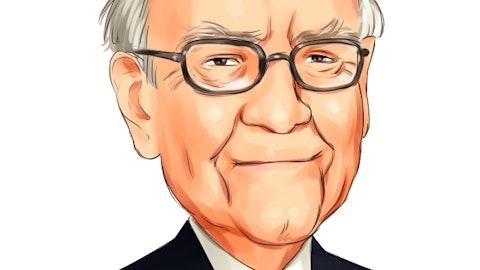Wells Fargo & Company (NYSE:WFC) is only up about 1% in the last three months, even as the S&P 500 has risen 5% and some bank stocks are even higher (Bank of America Corp (NYSE:BAC), for example, is up 30% in the same time frame). In early August, we’d argued that Citigroup Inc. (NYSE:C) and JPMorgan Chase & Co. (NYSE:JPM) were better buys than Wells Fargo, but is that still the case after Warren Buffett’s favorite bank has lagged the industry?
Wells Fargo & Company Board member Stephen Sanger apparently doesn’t think so. His trust purchased 10,000 shares of the bank on October 17th at an average price of $33.96. We track insider purchases because insider generally shouldn’t be willing to expose more of their wealth to the same company unless they are very confident in its future prospects- and studies show that they tend to be bullish signs for a stock (read our analysis of studies on insider trading). Sanger’s last insider purchases at Wells Fargo, according to our database of insider purchases and sells, came in January 2009 at an average price of about $19.90; the stock is up 73% since then.
We’ve already mentioned Buffett’s preference for Wells Fargo. At the end of June, the 411 million shares of the bank that Berkshire Hathaway owned- a 4% increase from the beginning of April, as the holding company bought an additional 17 million shares-made it the second largest position in Berkshire’s 13F portfolio (find more of Warren Buffett’s favorite stocks). Buffett wasn’t alone in the finance community in liking Wells Fargo, as interest from hedge funds and other notable investors made it one of the most popular stocks in our database of 13F filings for the end of the second quarter (see more of the most popular stocks among hedge funds).
Wells Fargo & Company exploited a widening of interest rate spreads during the third quarter of 2012 as interest income fell by 2% but interest expense fell 23%. Noninterest income and expenses were also up, and in total the bank grew its net income available to common shareholders by 23%. This built on further gains that Wells Fargo saw earlier this year; in the first nine months of 2012, earnings per share were $2.45 as opposed to $2.09 at the same point in 2011. Wells Fargo still trades at a premium to the book value of its shares, with a P/B ratio of 1.3, but does have a reputation for being a safer bank and on an earnings basis it doesn’t look particularly expensive with a forward P/E of 9 based on analyst estimates for 2013.
Bank of America and Citi have both outperformed Wells Fargo over the last three months, but still trade at substantial discounts to their own book value. Bank of America’s P/B has climbed to 0.5 while Citi’s is 0.6; this means that their book values are actually greater than Wells Fargo’s even though their market caps of about $100 billion are considerably lower. As far as the ability to generate income from those assets, however, the two banks lag far behind and on an earnings basis the three are priced about even with each other. Wells Fargo’s forward P/E of 9 places it square between them, with Citi trading at 8 times forward earnings estimates and Bank of America’s forward earnings multiple being 10.
JPMorgan Chase and PNC Financial Services (NYSE:PNC) have seen double-digit growth rates in their earnings recently and, while perhaps not having quite as good a reputation as Wells Fargo, would generally not be put into the same category as Bank of America or Citi either. As such, we see them trading at small discounts to book value: P/B ratios of 0.9 and 0.8, respectively. JPMorgan Chase and PNC trade at 8 and 9 times forward earnings estimates, in the same range as the three banks we’ve already discussed.
In book value terms, there seems to be a steady continuum from the safe, high-priced Wells Fargo to the questionable, discounted Citigroup and Bank of America. Partly due to Wells Fargo’s underperformance, however, we’ve seen the entire industry converge on a forward earnings basis. Particularly with an insider buying, it’s certainly time to unwind any “short Wells Fargo, long other banks” pair trade that may have been put in place a few months ago.






